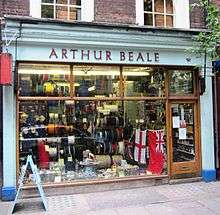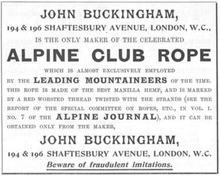Arthur Beale
Arthur Beale is a yacht-chandler on London's Shaftesbury Avenue that stocks a wide variety of nautical equipment and accessories. The business started as the rope-maker John Buckingham by the nearby Fleet river in the 16th century and has been based in premises in Bloomsbury since then. In the 19th century, they became known as the exclusive suppliers of climbing rope to the Alpine Club. They still make and stock a large variety of ropes and lines and so also supply theatrical rigging and ornamental ropes for decoration and crowd control.

History

The business started as rope-maker, John Buckingham, on the Fleet river at the start of the 16th century.[1] In the early 19th century, they had premises at number 6 in the Middle Row of St Giles—an impressive terrace in the middle of Broad Street—but had to move when this was demolished in 1843.[2]
They then operated from premises on Shaftesbury Avenue when John Buckingham and then the new proprietor, Arthur Beale, were exclusive suppliers of climbing rope to early members of the Alpine Club.[3] This was made to the club's specification so that it was both light and strong, being made from three strands of manila hemp, treated to be rot proof and marked with a red thread of worsted yarn.[3] This rope was used for British expeditions to Mount Everest and Antarctica.[4] It also supplied ice axes to polar explorer, Ernest Shackleton; the flagpole for Buckingham Palace and rigging for escapologists and the window displays of Selfridges department store.[5]

The business now trades mainly as a yacht chandler, stocking and supplying nautical equipment such as a monkey's fist – a weighted ball of rope used for line-throwing.[6] To support the retailing, they have a workshop downstairs, where they produce special orders for ropes and rigging.[7] This business was declining but, in 2014, veteran sailor and theatrical chandler, Alasdair Flint, took over with business partner Gerry Jeatt and plans to revive it.[8]
Reviews
Eugenia Bell, writing in The Traditional Shops and Restaurants of London, praised the establishment:[9]
The teal shopfront matches the pegboards inside, festooned with gleaming brass shackles, bolts and hooks of every size and description. Spools of ropes adorn all sides of the store and rigging is still assembled in a downstairs workshop. Beale's is a stunning shop, as much for its incongruity as for its dazzling display.
In 1999, Time Out likewise commented on their incongruity but praised the range of nautical equipment:[10]
There are some odd shops in London, but few beat the surprise factor of finding a yacht chandler in Shaftesbury Avenue. Arthur Beale is a retail survivor, hanging on long after many of the other chandlers went bust. It may look old-fashioned – and it stubbornly holds out against this new-fangled internet thing – but the stock is as useful now as it ever was for sailors.
References
- The London Encyclopedia, 2008, p. 832, ISBN 9781405049245
- Deborah Colville (14 April 2011), "Middle Row Bloomsbury", UCL Bloomsbury Project
- George Dixon Abraham (1908), The Complete Mountaineer, p. 58
- Arthur Beale Summer Watch (PDF), 2014, archived from the original (PDF) on 11 July 2014
- Christian House (31 March 2016), "Best of British: Arthur Beale Chandlery", Daily Telegraph
- Benedict Le Vay (2012), "The Shops That Time Forgot", Ben Le Vay's Eccentric London: A Practical Guide to a Curious City, pp. 90–91, ISBN 9781841623948
- Sally Venables, Steve Williams (2006), Still Open: The Guide to Traditional London Shops, ISBN 978-1904772446
- Gavin Atkin (4 July 2014), "Tilman medal winner Alasdair Flint and business partner Gerry Jeatt rescue historic London chandlers Arthur Beale", In the Boat Shed
- Eugenia Bell (2010), "Arthur Beale", The Traditional Shops and Restaurants of London, p. 193, ISBN 1-892145-95-2
- Arthur Beale, Time Out, 30 November 1999
External links
- Arthur Beale – official website
- Master Mechanics of the Wind – an interview with Bill Keitel